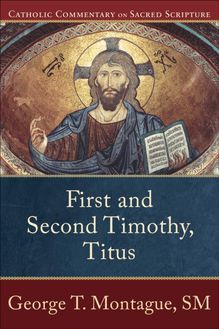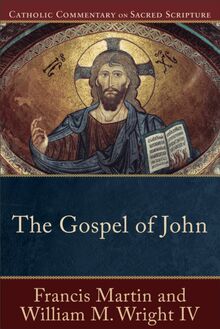Revelation (Catholic Commentary on Sacred Scripture) , livre ebook
210
pages
English
Ebooks
2015
Vous pourrez modifier la taille du texte de cet ouvrage
Obtenez un accès à la bibliothèque pour le consulter en ligne En savoir plus
Découvre YouScribe en t'inscrivant gratuitement
Découvre YouScribe en t'inscrivant gratuitement
210
pages
English
Ebooks
2015
Vous pourrez modifier la taille du texte de cet ouvrage
Obtenez un accès à la bibliothèque pour le consulter en ligne En savoir plus
Publié par
Date de parution
10 mars 2015
Nombre de lectures
0
EAN13
9781441219640
Langue
English
Poids de l'ouvrage
2 Mo
Publié par
Date de parution
10 mars 2015
Nombre de lectures
0
EAN13
9781441219640
Langue
English
Poids de l'ouvrage
2 Mo
Catholic Commentary on Sacred Scripture
S ERIES E DITORS
Peter S. Williamson
Mary Healy
A SSOCIATE E DITOR
Kevin Perrotta
C ONSULTING E DITORS
Scott Hahn , Franciscan University of Steubenville
†Daniel J. Harrington, SJ , Weston Jesuit School of Theology
William S. Kurz, SJ , Marquette University
†Francis Martin , Sacred Heart Major Seminary
Frank J. Matera , Catholic University of America
George Montague, SM , St. Mary’s University
Terrence Prendergast, SJ , Archbishop of Ottawa
© 2015 by Peter S. Williamson
Published by Baker Academic
a division of Baker Publishing Group
P.O. Box 6287, Grand Rapids, MI 49516-6287
www . bakeracademic . com
Ebook edition created 2015
Ebook corrections 03.14.2018
All rights reserved. No part of this publication may be reproduced, stored in a retrieval system, or transmitted in any form or by any means—for example, electronic, photocopy, recording—without the prior written permission of the publisher. The only exception is brief quotations in printed reviews.
Library of Congress Cataloging-in-Publication Data is on file at the Library of Congress, Washington, DC.
ISBN 978-1-4412-1964-0
Printed with Ecclesiastical Permission
Most Reverend Earl Boyea
June 19, 2014
The nihil obstat and imprimatur are official declarations that a book is free of doctrinal or moral error. No implication is contained therein that those who have granted the nihil obstat or imprimatur agree with the contents, opinions, or statements expressed.
Except as otherwise specified, Scripture versification and quotations are from the New American Bible, revised edition © 2010, 1991, 1986, 1970 Confraternity of Christian Doctrine, Washington, DC, and are used by permission of the copyright owner. All rights reserved. No part of the New American Bible may be reproduced in any form without permission in writing from the copyright owner.
Scripture quotations labeled ESV are from The Holy Bible, English Standard Version® (ESV®), copyright © 2001 by Crossway, a publishing ministry of Good News Publishers. Used by permission. All rights reserved. ESV Text Edition: 2007
Scripture quotations labeled NET are from the NET BIBLE®, copyright © 2003 by Biblical Studies Press, LLC. www.netbible.com . Used by permission. All rights reserved.
Scripture quotations labeled NIV are from the Holy Bible, New International Version®. NIV®. Copyright © 1973, 1978, 1984, 2011 by Biblica, Inc.™ Used by permission of Zondervan. All rights reserved worldwide. www.zondervan.com
Scripture quotations labeled NJB are from THE NEW JERUSALEM BIBLE, copyright © 1985 by Darton, Longman & Todd, Ltd. and Doubleday, a division of Random House, Inc. Reprinted by permission.
Scripture quotations labeled NRSV are from the New Revised Standard Version of the Bible, copyright © 1989, by the Division of Christian Education of the National Council of the Churches of Christ in the United States of America. Used by permission. All rights reserved.
Scripture quotations labeled RSV are from the Revised Standard Version of the Bible, copyright 1952 [2nd edition, 1971] by the Division of Christian Education of the National Council of the Churches of Christ in the United States of America. Used by permission. All rights reserved.
English translation of the Catechism of the Catholic Church for the United States of America copyright © 1994, United States Catholic Conference, Inc.—Libreria Editrice Vaticana. English translation of the Catechism of the Catholic Church: Modifications from the Editio Typica copyright © 1997, United States Catholic Conference, Inc.—Libreria Editrice Vaticana.
“The Catholic Commentary on Sacred Scripture richly provides what has for so long been lacking among contemporary scriptural commentaries. Its goal is to assist Catholic preachers and teachers, lay and ordained, in their ministry of the Word. Moreover, it offers ordinary Catholics a scriptural resource that will enhance their understanding of God’s Word and thereby deepen their faith. Thus these commentaries, nourished on the faith of the Church and guided by scholarly wisdom, are both exegetically sound and spiritually nourishing.”
— Thomas G. Weinandy, OFM Cap , United States Conference of Catholic Bishops
“This could be the first commentary read by a pastor preparing a text and could be read easily by a Sunday School teacher preparing a text, and it would be an excellent commentary for a college Bible class. . . . The Catholic Commentary on Sacred Scripture will prove itself to be a reliable, Catholic—but ecumenically open and respectful—commentary.”
— Scot McKnight , Jesus Creed blog
“This commentary series should meet a need that has long been pointed out: a guide to Scripture that will be both historically responsible and shaped by the mind of the Church’s tradition. It promises to be a milestone in the recovery of a distinctively Catholic approach to exegesis.”
— Aidan Nichols, OP , University of Oxford; Fellow of Greyfriars, Oxford
“There is a great hunger among Catholic laity for a deeper understanding of the Bible. The Catholic Commentary on Sacred Scripture fills the need for a more in-depth interpretation of Scripture. I am very excited to be able to recommend this series to our Bible Study groups around the world.”
— Gail Buckley , founder and director, Catholic Scripture Study International (www.cssprogram.net)
“Coinciding with the Bishops’ Synod on ‘The Word of God in the Life and Mission of the Church,’ this great project of a seventeen-volume commentary on the New Testament represents a much-needed approach, based on good scholarship but not overloaded with it. The frequent references to the Catechism of the Catholic Church help us to read Holy Scripture with a vivid sense of the living tradition of the Church.”
— Christoph Cardinal Schönborn , Archbishop of Vienna
To my wife, Marsha Daigle-Williamson, and to my mother, Beulah Pederson Williamson, with gratitude and love
Contents
Cover 1
Series Page 2
Title Page 3
Copyright Page 4
Endorsements 5
Dedication 6
Illustrations 9
Editors’ Preface 11
Abbreviations 15
Introduction 17
Outline of Revelation 37
A Revelation from Jesus Christ (1:1–20) 39
Words from Jesus to the Churches (2:1–29) 56
More Messages to the Churches (3:1–22) 83
The Worship of Heaven (4:1–11) 98
The Lamb and the Scroll (5:1–14) 106
The First Six Seals (6:1–17) 119
Visions of God’s People (7:1–17) 137
The Beginning of the Seven Trumpets (8:1–13) 152
The Woes Experienced by the Inhabitants of the Earth (9:1–21) 165
The Open Scroll (10:1–11) 179
The Temple of God, the Two Witnesses, and the Seventh Trumpet (11:1–19) 185
The Woman, the Dragon, and the Male Child (12:1–18) 205
The Two Beasts (13:1–18) 221
The Lamb’s Companions, the Eternal Gospel, and the Harvest of the Earth (14:1–20) 239
Seven Angels with Seven Plagues; the Song of Moses and the Lamb (15:1–8) 254
The Bowls of God’s Wrath (16:1–21) 260
The Harlot and the Beast (17:1–18) 271
Judgment of Babylon (18:1–24) 287
Celebration in Heaven, Judgment on Earth (19:1–21) 305
The Millennium, the Dragon’s Defeat, and the Final Judgment (20:1–15) 319
The New Creation and the Bride of the Lamb (21:1–27) 341
The River of Life and Concluding Words (22:1–21) 357
Suggested Resources 369
Glossary 371
Index of Pastoral Topics 375
Index of Sidebars 377
Map 379
Back Cover 380
Illustrations
Figure 1. Bust of Domitian 21
Figure 2. Circular progression of Revelation 24
Figure 3. Altar to Zeus 70
Figure 4. Nike, goddess of victory, from Ephesus 86
Figure 5. Remains of Laodicea, main street 93
Figure 6. Albrecht Dürer’s “Four Horsemen” 125
Figure 7. Fourth trumpet 160
Figure 8. Sixth trumpet 171
Figure 9. The open temple, the ark, the beast ascending 203
Figure 10. The woman and the dragon 220
Figure 11. Worship of the dragon and the beast 223
Figure 12. Bust of Nero 235
Figure 13. Adoration of the lamb on Mount Zion 243
Figure 14. Bar Kochba coin with image of harp and trumpets 256
Figure 15. Seven bowls of wrath to seven angels 258
Figure 16. Pouring out of the fifth bowl on the throne of the beast 264
Figure 17. Harlot on beast with cup in hand 273
Figure 18. Victory of the Lamb 280
Figure 19. Flames descend on Babylon 292
Figure 20. The coming of Christ with the armies of heaven 313
Figure 21. The new Jerusalem with twelve courses of stones as its foundation 349
Figure 22. The river of life, seeing God’s face 359
Editors’ Preface
The Church has always venerated the divine Scriptures just as she venerates the body of the Lord. . . . All the preaching of the Church should be nourished and governed by Sacred Scripture. For in the sacred books, the Father who is in heaven meets His children with great love and speaks with them; and the power and goodness in the word of God is so great that it stands as the support and energy of the Church, the strength of faith for her sons and daughters, the food of the soul, a pure and perennial fountain of spiritual life.
Second Vatican Council, Dei Verbum 21
Were not our hearts burning [within us] while he spoke to us on the way and opened the scriptures to us?
Luke 24:32
The Catholic Commentary on Sacred Scripture aims to serve the ministry of the Word of God in the life and mission of the Church. Since Vatican Council II, there has been an increasing hunger among Catholics to study Scripture in depth and in a way that reveals its relationship to liturgy, evangelization, catechesis, theology, and personal and communal life. This series responds to that desire by providing accessible yet substantive commentary on each book of the New Testament, drawn from the best of contemporary biblical scholarship as well as the rich treasury of the Church’s tradition. These volumes seek to offer scholarship illumined by faith, in the conviction that the ultimate aim of biblical interpretation is to discover what God has revealed and is still speaking through the sacred text











